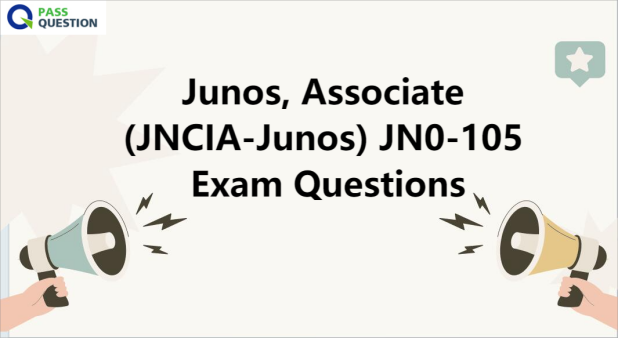
Junos, Associate (JNCIA-Junos) JN0-105 Exam Questions
The JN0-105 Junos, Associate (JNCIA-Junos) exam is a recently introduced exam that replaces the retired JN0-104 exam. If you are planning to take this exam, you can find the latest Junos, Associate (JNCIA-Junos) JN0-105 Exam Questions from PassQuestion. These exam questions are specifically designed to assist you in passing your exam with ease. By utilizing the comprehensive set of Junos, Associate (JNCIA-Junos) JN0-105 Exam Questions, you will gain a deep understanding of all the exam topics, ensuring that you are well-prepared and able to achieve your certification efficiently. With these Junos, Associate (JNCIA-Junos) JN0-105 Exam Questions, you will be equipped with the necessary knowledge and skills to excel in your exam and secure your certification.

JN0-105 Junos, Associate (JNCIA-Junos) Exam
The JNCIA-Junos certification is designed for networking professionals who have a basic understanding of networking concepts. This certification provides a thorough assessment of your knowledge and skills in using the Juniper Networks Junos OS, a well-known operating system that is used in various networking devices. By passing the written exam, you will not only show your ability to understand and use the core features of the Junos OS, but also establish your expertise in network administration and management in the Juniper Networks ecosystem. This certification is highly regarded in the industry and can greatly enhance your career prospects by validating your proficiency in networking technologies and practices.
JNCIA-Junos Exam Information
Exam Code: JN0-105
Prerequisite Certification: None
Delivered by: Pearson VUE
Exam Length: 90 minutes
Exam Type: 65 multiple-choice questions
Software Versions: Junos OS 21.2
JNCIA-Junos Exam Topics
Networking Fundamentals
Junos OS Fundamentals
User Interfaces
Configuration Basics
Operational Monitoring and Maintenance
Routing Fundamentals
Routing Policy and Firewall Filters
What are the benefits of earning JNCIA-Junos Certification?
The benefits of earning JNCIA-Junos Certification are numerous. Firstly, it allows for a comprehensive assessment of your knowledge and skills in utilizing the Junos OS, ensuring that you have a deep understanding of its functionalities. Additionally, this certification serves as a validation of your proficiency in various networking technologies and practices, showcasing your expertise to potential employers. By establishing yourself as an expert in network administration and management within the Juniper Networks ecosystem, you position yourself for enhanced career prospects in the industry. Furthermore, acquiring this certification demonstrates your ability to effectively utilize the core features of the Junos OS, making you an invaluable asset in the networking field.
View Online Junos, Associate (JNCIA-Junos) JN0-105 Free Questions
1. In Junos routing policies, what does a 'from' statement specify?
A. Match criteria for a policy
B. Action to be taken if the criteria are met
C. The destination of the routing updates
D. The source of the routing information
Answer: A
2. At which two layers of the OSI model does Ethernet operate? (Choose two.)
A. Physical Layer
B. Transport Layer
C. Logical Layer
D. Data Link Layer
Answer: A, D
3. When 'longest match' routing is referenced, what property of a route is 'longest'?
A. IP address
B. subnet mask
C. metric
D. preference
Answer: B
4. In a Junos firewall filter, what is the purpose of the 'then' statement?
A. To specify the source of the filter
B. To determine the traffic direction
C. To define the action taken when criteria are met
D. To list the protocols to be filtered
Answer: C
5. You have the policy configuration shown in the exhibit applied to your BGP peering. You find that your customer routes coming from the 10.1.1.0/24 network are being rejected.
Which command should be used to correct the problem?
A. [edit policy-options policy-statement my-policy) user@router# rename term 1 to term 3
B. [edit policy-options policy-statement my-policy) user@router# insert term 1 before term 2
C. [edit policy-options policy-statement my-policy) user@router# copy term 2 to term 0
D. [edit policy-options policy-statement my-policy) user@router# insert term 2 before term 1
Answer: D
6. Which three statements are true about IPv6 linl local addresses? (Choose three.)
A. They begin with the prefix fe80::/64.
B. They can be assigned manually or dynamically.
C. They are not guaranteed to be unique outside of the network segment.
D. They are optional adddresses.
E. They provide reachability to the internet.
Answer: A, B, C
7. How many previous commits are stored by default on most Juniper devices?
A. 5
B. 10
C. 50
D. 100
Answer: C
8. Where are log files stored on a Junos device?
A. /log/
B. /etc/log/
C. /usr/log/
D. /var/log/
Answer: D
9. What are two important steps when upgrading an SRX300 Series device? (Choose two.)
A. Reboot the device.
B. Clear all alarms.
C. Verify that enough space exists to upload the software package.
D. Verify that the netconf protocol is enabled.
Answer: A, C
10. Which protocol connects multiple autonomous systems?
A. OSPF
B. EBGP
C. IS-IS
D. IBGP
Answer: A
SIIT Courses and Certification
Also Online IT Certification Courses & Online Technical Certificate Programs

